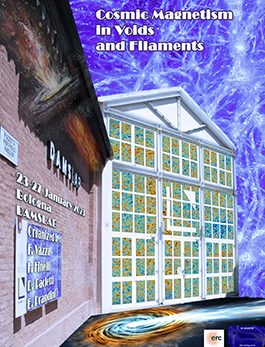Speaker
Description
Primordial Intergalactic Magnetic Fiels (IGMF) are a long-lived cosmological question, they could have played a crucial role in the early evolution of the universe but efforts to discover its properties have been so far inconclusive, with only limits put in place using different methods and techniques, current limits allow strengths between $10^{-7}$ nG and 1 nG for a coherence length of 1Mpc. This primordial seed field is the progenitor of the $\mu$Gauss fields currently detectable on structures through compression or dynamo amplification processes. The most promising observable test for small intensity IGMF in voids is the extended secondary emission that develops from cascades initiated by TeV blazar photons interacting with EBL through pair production, these charged component can then Inverse Compton upscatter CMB photons into a second generation of gamma-rays. The extent and spectrum of this secondary emission depends (among other few parameters) on the properties of the intervening IGMF. In this work, we aim to detect and characterize the extended secondary emission around the line of sight to a Fermi-LAT sample of nearby Extreme TeV Blazars (ETB). Our proposed method involves analyzing the available 14 years of data from Fermi-LAT, and fitting simulated models produced with ELMAG that include both the spatial distribution, as well as the spectrum for the extended component as it would be observed after developing under different IGMF strengths. We can obtain an improved sensitivity to this detection by fitting different flux states of the ETB sources independently. Prelim. We find evidence for an angular extension of 0.04 degrees around blazar MKN421. The extended emission is consistent with a IGMF of magnitude $10^{-16}$ Gauss and coherence length of 1 Mpc. This field properties are compatible with an astrophysicial origin. As expected we also find the cascade contribution to be more significant at the low-flux state. These results are allowed by most of the limits placed on the IGMF parameter space.

